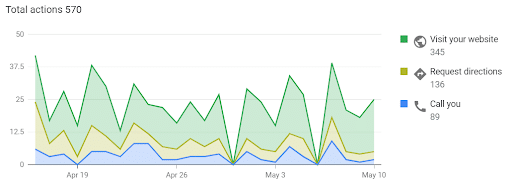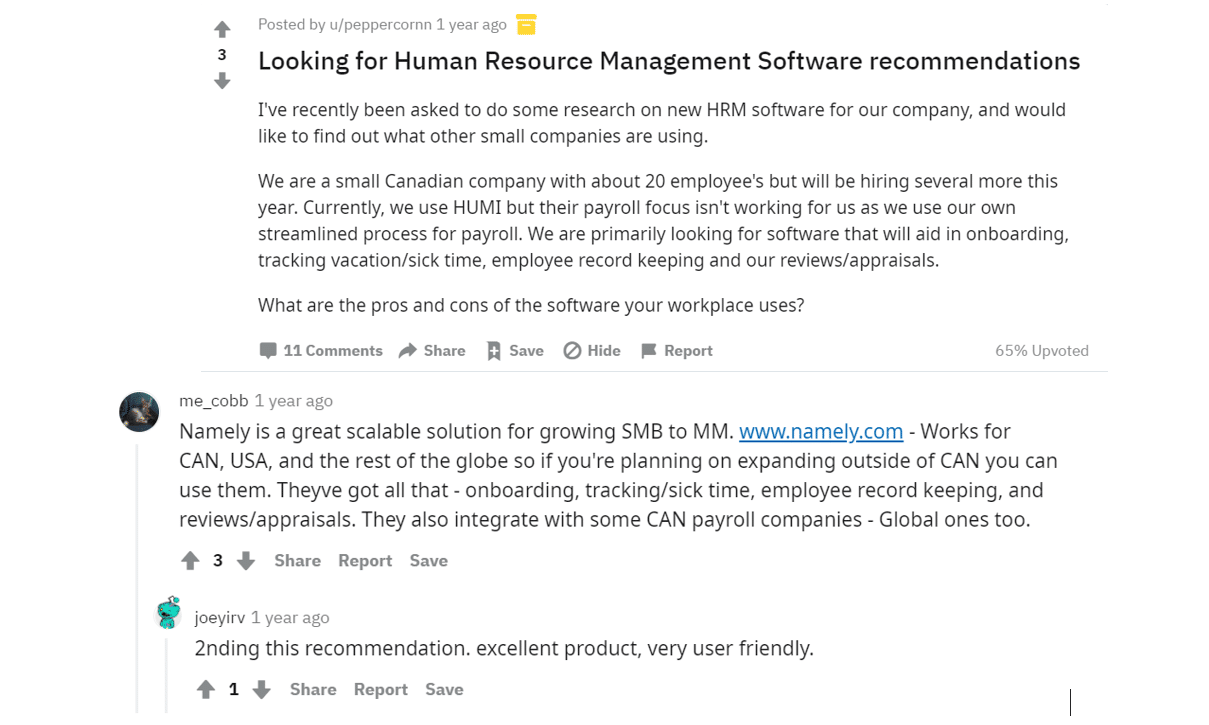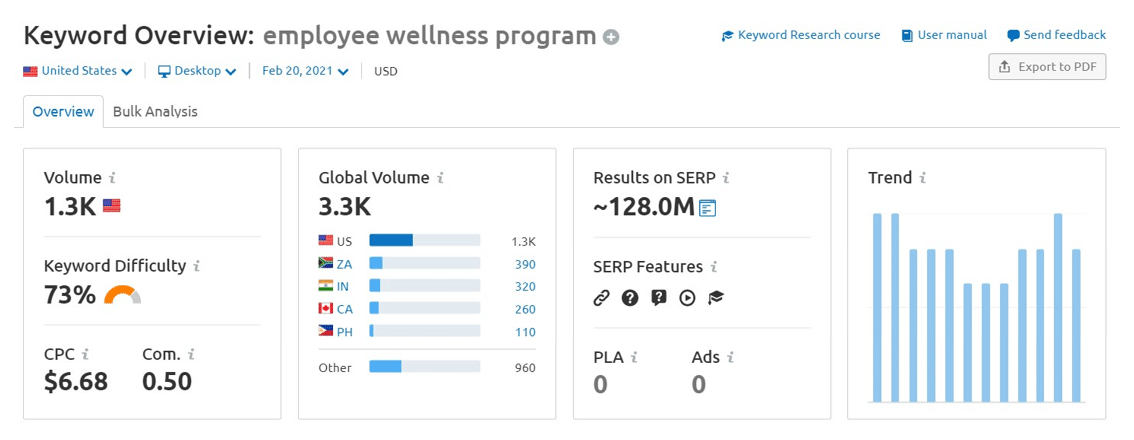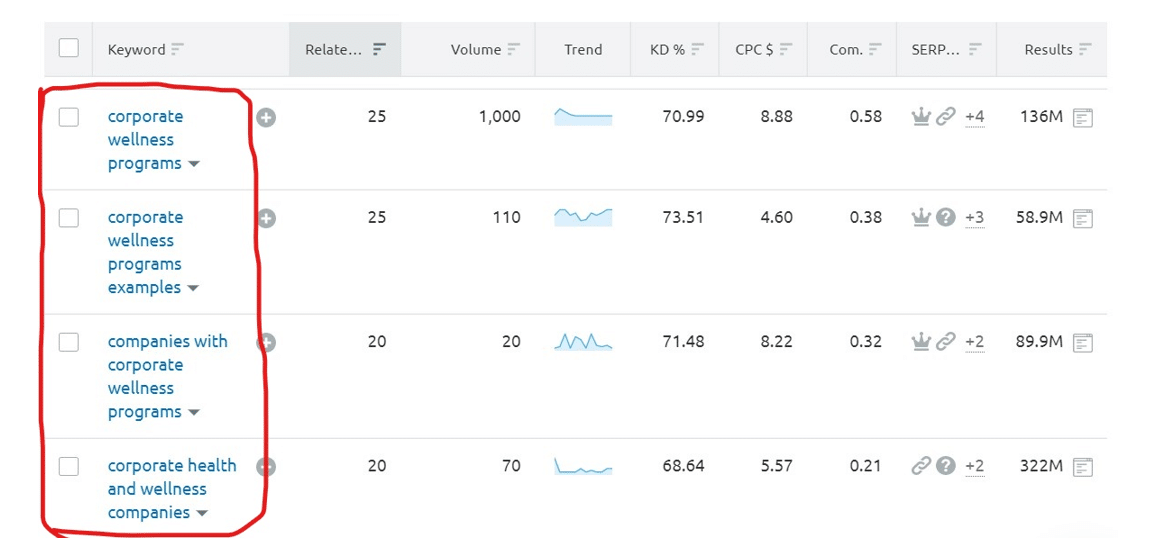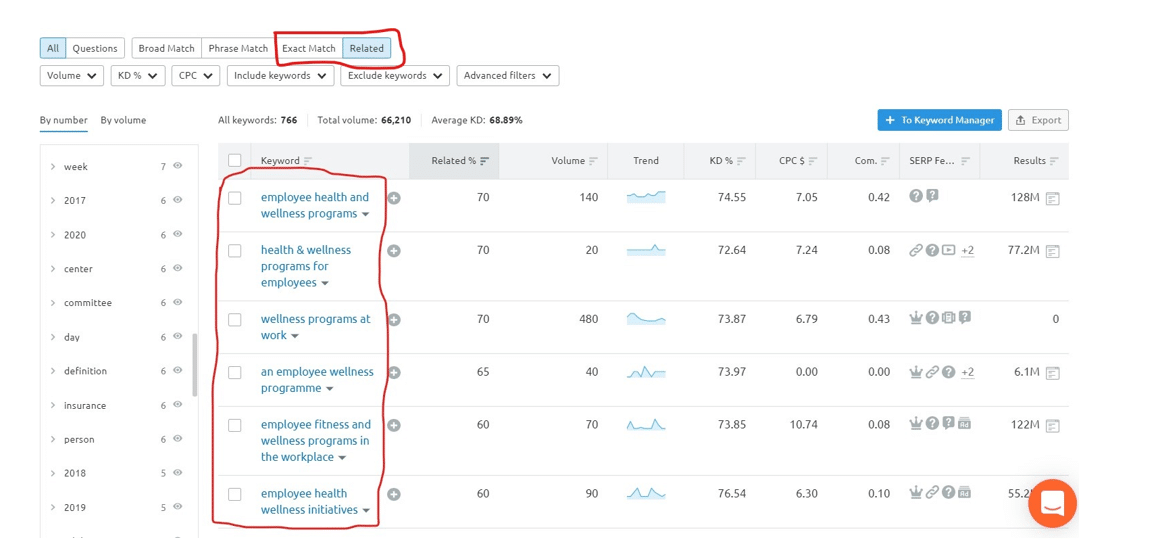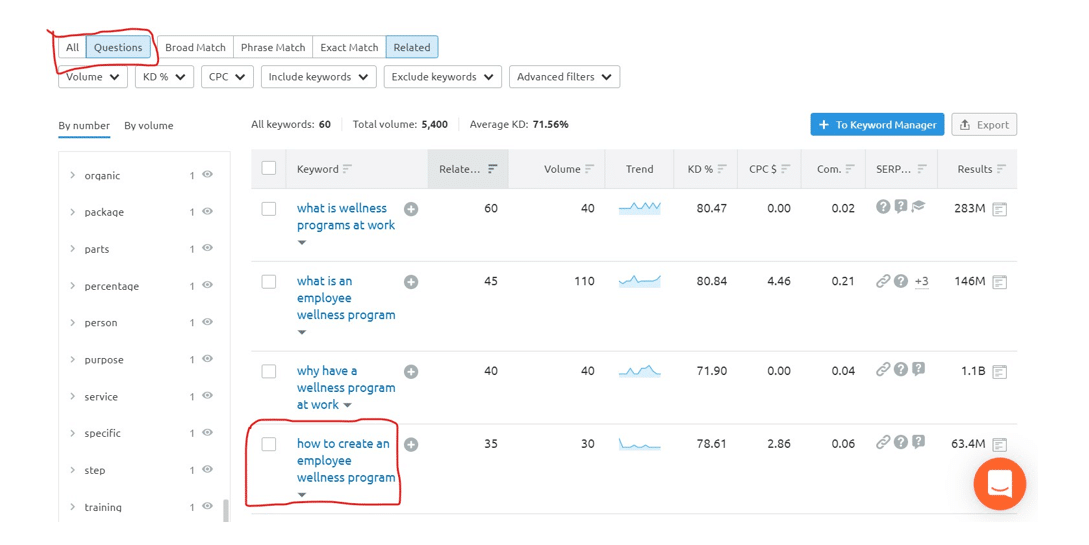What is B2B SEO and How is it Different from B2C SEO?
To understand B2B Search Engine Optimization (SEO), you first need to understand SEO in general.
SEO is any practice that helps pages on your website show up on Google and other search engines. By showing up on Google, your website can generate more traffic which can lead to increased sales and revenue.
Now that you understand SEO in general, what is B2B SEO?
B2B SEO helps business professionals find your website when they search on Google and other search engines.
It’s basically the same as normal SEO, except you’re targeting keywords/topics that professionals are searching for. There are several unique SEO quirks and strategies for B2B companies, which we’ll share in this guide.
What are some examples of B2B SEO?
- An HR Executive searching for “best HR software”
- A Director of Finance searching for “invoicing software with low fees”
- A small business owner looking for “Google Ads consultant”
- A university searching for “custom bulk t-shirt company”
How is B2C SEO different from B2B SEO?
The difference is straightforward; B2C SEO targets consumers while B2B SEO targets professionals working for companies.
What are examples of B2C SEO to show how it’s different from B2B SEO?
- A millennial searching for “all-natural face products”
- A baby boomer searching for “assisted living community near me”
- A parent searching for “best video games to teach Spanish to my kids”
B2B SEO Statistics in 2021
B2B SEO is steadily growing. Here are some statistics:
- 57% of B2B marketers stated that SEO generates more leads than any other marketing initiative.
- B2B (business-to-business) marketers receive 67% more leads if they have a blog.
Why is B2B SEO growing so rapidly? There are a variety of reasons, such as:
- COVID-19 Pandemic: the world had to go virtual nearly instantaneously. Businesses using outdated digital marketing practices had to play catch-up.
- More professionals are using Google to buy: business professionals looking for B2B solutions initially go to search engines like Google to start their search.
- Competition: for B2B companies such as software companies, consultants, medical device companies, and others, competition is increasing. With more competition, B2B companies are doubling down on SEO to outperform competitors.
High-Level B2B SEO Roadmap for 2021
B2B SEO is complex. It can include dozens of micro-strategies, like:
- Backlinks
- Content optimization
- Keyword research
- Data tracking
- PR campaigns
- Technical SEO
- Site speed
- Content creation
- B2B Youtube SEO strategies
- Internal linking
- External linking
- User experience (especially with Google’s 2021 Page Experience Update)
- Conversion strategies
- …and much more
With so many micro-strategies and limited resources, what strategies should you focus on?
At SEOReseller, our high-level B2B SEO roadmap for 2021 has four pillars.
- Content:
Content that follows SEO best practices helps your website rank for valuable B2B SEO keywords that you likely wouldn’t rank for otherwise. - Technical SEO best practices: If your website has critical technical SEO errors, such as 404 errors, mobile-friendliness issues, or non-compressed images, then your competitors could be outperforming you.
- Off-Page SEO: Google considers the authority of your website for SEO. By building high-authority, natural backlinks, then Google will view your website as an authority. This will likely lead to better SEO performance.
- Data Tracking: Without meticulously tracking data, how will you know if your B2B SEO campaign is performing? You won’t. It’s critical that you track data over time. You should track data like keyword rankings, organic traffic, and conversions. Our comprehensive B2B SEO dashboards allow you to track this data with ease.
The four pillars provide a starting point. But if you want to take your B2B SEO to the next level, continue reading the 11 in-depth strategies. We walk you through, step-by-step, how to refine your B2B SEO strategy to grow your digital presence.
B2B SEO Case Studies
We’ve used the 11-step B2B SEO strategy below to get results. The two examples below showcase that the strategy in this guide follows SEO best practices and can get your business similar results.
Improved Conversions for a Dog Trainer Service Provider
Overview
Our client is based in Jacksonville, Florida, and offers dog and puppy training services specializing in obedience training and behavior modification. With years of experience in canine behavior, they were able to establish a customer base in their local area. However, they were facing some roadblocks.
Challenges
– They have limited traffic and they don’t garner enough leads to convert
– Lack of Relevance on Local Search affects their opportunities of having more clients within their community.
– Their online presence is not as strong and doesn’t provide the extra push to get more visitors to their website.
Our Approach
Keyword Targeting. Keyword research is the foundation of an effective local SEO strategy. To make sure the client improves their relevance and visibility in their local area, we focused our SEO efforts on five geo-targeted keywords:
Local Citations and Google My Business Optimization
Our local SEO strategy includes building citations on local websites, listings, and directories that the client’s target audience visits. We optimized the client’s GMB along with their relevant local citation to make it easier for customers to contact their business.
On-page and Technical Optimization
Based on our findings in the initial SEO audit, we optimized the website’s on-page elements to improve its performance and include target keywords. These includes:
- Meta Data optimization
- Image alt tag optimization
- Content creation and optimization
- Local schema implementation
- Pagespeed improvements
After optimizing the client’s website, we started building high-quality backlinks to websites that are relevant to their industry and have a high Domain Authority.
Results
With the client’s campaign still active, they were able to see improvements with their website. They started getting consistent growth in traffic, which contributes to more engagements with their customers.
- First page positions on search results for all target keywords.
- 10% conversion rate on their website, producing an estimate of 70 phone calls in a span of 30 days.
- Google My Business data show the following improvements:
- 89 phone calls
- 345 website visits
- 136 search users requesting directions to their location
Read the full case study here.
How an Ecommerce Website Increased its Revenue by 175% in 2 Years
Overview
Our client is an e-commerce website supplying a range of fencing, deck railings, and gate materials for residential and commercial properties in the US for 10 years.
They’re one of the first to sell fencing and gate installation materials online, allowing them to establish a presence in the home improvement industry.
Challenge
– Recover from a Google Penalty from previous activities and updates. The client’s website was affected by the Penguin update, which had a significant impact on their rankings.
– Get Targeted Traffic
– Lack of online traffic, lead, and sales.
Our Approach
First on the list was to identify the causes of the website’s Google penalty and implement remedies to regain rankings.
We did a technical audit that analyzed the on-page and off-page performance of the website. Next, the website’s content was reviewed and checked for its quality and relevance to its audience, target keywords, and overall brand.
Fixing website issues was also a major priority. We dedicated web development hours to fix minor issues on the website, such as slow site speed.
Applying the best practices we were able to elevate the client’s online performance. Here is the list of recommended SEO services the client used to build the basics for their website:
-
Target customer analysis and buyer persona creation: To determine the best keywords and write content for the website, we developed a buyer persona profile for the business.
-
Keyword research: Based on their ideal customer profiles, we identified their target keywords and tracked them into the dashboard. This enabled us to monitor ranking movement for targeted search terms.
-
Website Optimization: We proceeded to optimize relevant pages and content. Using the target keywords, we start linking contextually related pages with one another.
-
Link Building: Our team reached out to high domain authority online publications and blogs to develop articles that produce backlinks for the website.
Results
Two months after they started their SEO project, the client’s website showed a significant increase in their rankings.
In two years of running a campaign with us, we were able to hit all of their goals:
-
98% increase in organic conversions
-
175% growth in total revenue
-
40% increase in unique transactions
-
97% increase in the average order value
-
31,280 search volume of targeted terms ranking on the first page
Read the full case study here.
11-Step B2B SEO Strategy To Increase Traffic and Drive Conversions
1. Understand How Your Customer Avatar Shops For Your Product/Service
A high-performing SEO campaign starts with an understanding of how your customer avatar searches for your product/service. A customer avatar is a model of your ideal customer. Before you can dive into how your customer avatar searches on search engines like Google, you first need to understand who they are at a granular level.
For B2B SEO, your customer avatar should be a decision-maker within a company. Here are some questions you can ask yourself to build an accurate avatar:
- Who will make the final decision when buying my product/service? What is their role?
- What is their personality? How do they learn and make decisions? Their behavior will determine the language you use on your website. Should the language be scientific, professional, or casual?
- What size of company am I targeting?
- Where is the company located? Are they local, national, or international?
Now that you have an accurate customer avatar, you will likely have a better idea of how they search for your product/service online.
How Do You Gather Data On How Your Audience Shops?
You can use simple strategies to understand how your customer persona shops for your product/service.
An easy option is to go to Reddit: the professional community uses Reddit regularly, especially business owners/entrepreneurs.
- Example: If your B2B business sells HR software for small businesses, go to Reddit and search for something like “best HR software for small business?” Now, take a look at the screenshot below. You can see that professionals have engaged with this Reddit thread, giving you insight into what they care about.
Based on the comments within the Reddit thread, you can see that people care about “onboarding, tracking sick time, record keeping and reviews/appraisals.” They also care about integrating their HR software with payroll companies.
As you’re writing copy for your website, you can add similar elements since you know your customer avatar cares about them.
2. Gather All Relevant Keywords Through an Easy-To-Follow B2B Keyword Research Process
From Step 1, you now know what your customer avatar cares about during the buyer’s journey. But you still don’t know how they’re searching.
Let’s use the same B2B example above (a company that sells employee wellness programs to other companies). How does the decision-maker who’s looking to buy an employee wellness program search on Google? What keywords are they using in their search?
- Are they searching for “employee wellness program” or “corporate wellness program?”
- Does the keyword “employee wellness price” have a higher or lower search volume than “employee wellness cost”?
- Is the keyword “online corporate wellness program” better to target than “corporate wellness program app”?
These are the types of questions you need to ask yourself. The answer is easily found through B2B SEO keyword research.
Sidenote: B2B SEO, as you’ll discover throughout this guide, relies on intricate data analysis. To execute B2B SEO well, you need to become a data expert. Don’t be overwhelmed – there are tactical tips you can leverage to make it easier. Our team at SEO Reseller loves data. We’re data nerds. If you’re not a data person and you’re looking to improve your B2B SEO, contact us here for a free audit.
How Do You Conduct B2B SEO Keyword Research?
You can do keyword research using many tools. There are dozens that exist. Some are free and some are paid. SEMrush, Ahrefs, Ubersuggest, KW Finder, Moz, and Google Trends are a few of the tools that SEOs use to conduct keyword research.
While we have our preferred keyword tools, we are relatively tool-agnostic.
For the sake of this article, we will run through a step-by-step B2B keyword research process using SEMrush. We will use employee wellness programs as the B2B example.
Step 1: Login to SEMrush and enter your highest-value keyword in the “Keyword Magic Tool.” We’ve entered “employee wellness program.”
Step 2: Play around with keyword variations to see if people use different language. Go to the “related keyword” tab. For the example industry, people seem to use “employee wellness program” and “corporate wellness program” interchangeably. Good to know.
Step 3: Gather as many bottom-of-funnel keywords as possible. Bottom-of-funnel keywords are keywords that customer avatars are searching for when they’re ready to buy right now. For example, “best employee wellness program” and “employee wellness program cost” are bottom-of-funnel. A keyword like “workplace fitness ideas” is not bottom-of-funnel, as the user is likely not ready to buy an employee wellness program. An easy way to find bottom-of-funnel keywords is to toggle to the “related” keywords in SEMrush.
Step 4: Gather as many middle- and top-of-funnel keywords as possible. For example, thousands of people per year search for “employee fitness challenge.” People searching for this keyword may also be interested in an employee wellness program. An easy way to find middle- or top-of-funnel keywords is to sort by “questions” within SEMrush.
We have circled the keyword “how to create an employee wellness program?”, a valuable middle-of-funnel keyword for a B2B company selling employee wellness programs.
Step 5: Organize the keyword research into a spreadsheet. You can organize it by topic using different tabs. Within each topic, you can further organize each keyword by its value by considering its volume and competition level.
Step 6: Add all keywords to a keyword ranking tool so that you can determine if 1) you’re ranking for the keywords or 2) can track performance over time. Our affordable keyword ranking tool is an easy solution.
We have an entire team of experts who specialize in keyword research. If the 6-step process above feels overwhelming, reach out to us. Our team can find your B2B business’s most valuable keywords.
Pro Tip: Look Specifically For Long-Tail, Low-Volume Keywords
Many B2B companies can thrive on dominating Google for long-tail, low-volume keywords. What are long-tail, low-volume keywords? They’re keywords that have more than three words that also don’t have many people searching for them.
A keyword like “small business employee wellness program” is a long-tail, low-volume keyword. SEMrush, the keyword tool we use, shows that 0-10 people search for this keyword each month.
Even though long-tail keywords likely have low-volume, they still have high intent. Meaning that the people searching for them are ready to buy right now. Since competition for these keywords is usually weak, you can quickly slide in and dominate for them.
Even though many B2B companies can thrive on long-tail keywords, they usually don’t know that they exist. They’re not well-versed in B2B SEO so they usually overlook the keywords.
The good news? It’s likely that your competitors may not be aware of long-tail keywords, either. Or, if they are aware, they may not be targeting them. Capitalize on this!
3. Complete a Competitor Analysis (Especially Competitor Gap Analysis) To Find Low-Hanging Fruit Opportunities
SEO is not created equal across industries. You’re only competing against the other B2B players in your space. If you outperform all other competitors in your space, you win.
Each B2B space is different. Some are more competitive. Others are prime, undiscovered real estate.
Know your space by knowing your competitors’ SEO strategies. If you understand their SEO performance and how they got there, you can reverse-engineer their recipe. Then, you can refine it and make it better.
How Do You Conduct B2B SEO Competitor Analysis?
You can conduct a B2B SEO competitor analysis with a 3-step process:
- Browse each competitor’s website:
What does their home page look like? How have they set up their site architecture and navigation menu? Do they have a blog? If so, what topics are written on it? What is their main call-to-action?
You can learn a lot about each competitor by spending 30 minutes on their site.
- Determine your competitor’s most valuable keywords:
In a tool like SEMrush, you can find each competitor’s “top organic keywords.” You can also see which page is indexed for each keyword. This gives you insight into their SEO strategy.
For example, a competitor in the employee wellness industry might be ranking for the keyword “yoga at work.” After looking deeper, you see that they’ve created a basic blog post titled “3 Yoga Poses You Can Do at Work.” To outperform them, you can create a blog post that’s more comprehensive. Yours might be “7 Easy Yoga Poses To Do At Work.” Each yoga pose is accompanied by a short video explaining how to do it.
Do a competitor keyword gap analysis on each competitor so you can find every opportunity to outperform them. The next step walks you through how to do this.
- Gather the keywords that your competitors are ranking for that you’re not.
In a tool like SEMrush, you can conduct a “Keyword Gap Analysis.” You will see exactly which keywords your competitors are ranking for that you’re not.
You now know where you’re falling short of your competitors and what you can do about it.
4. Conduct a Comprehensive B2B SEO Content Audit To Determine How You’re Performing
According to Google’s guide titled Steps To a Google Friendly Site, “provide high-quality content on your pages, especially your homepage. This is the single most important thing to do.”
Read the last sentence one more time. As you read it, remember that Google is the one writing this.
“Providing high-quality content on your pages… is the single most important thing to do.”
Taking notice yet? If not, you should be.
Google describes in detail what it believes “quality content” should look like. They have an entire section on their Webmaster Guidelines regarding quality. The “Basic Principles” are so important that we’ve included all of them, word-for-word, below:
- Make pages primarily for users, not for search engines.
- Don’t deceive your users.
- Avoid tricks intended to improve search engine rankings. A good rule of thumb is whether you’d feel comfortable explaining what you’ve done to a website that competes with you, or to a Google employee. Another useful test is to ask, “Does this help my users? Would I do this if search engines didn’t exist?”
- Think about what makes your website unique, valuable, or engaging. Make your website stand out from others in your field.
Google clearly cares about the quality of the content on your site. You should too.
To improve the quality of the content on your site, you first have to analyze its current quality. A thorough audit reveals the cobwebs, leaky pipes, and sometimes worse, like a faulty foundation.
Without an audit, you might not catch the faulty foundation which means you won’t fix it. If you don’t fix it, your future SEO efforts likely won’t perform as well as you’d hoped. Don’t skip the audit.
How Do Conduct a B2B SEO Content Audit for Your Website?
There are so many things to analyze when conducting a B2B SEO content audit that we could write another guide on this step alone.
For the sake of time, steps for a simplified B2B SEO content audit look like this:
- Read Google’s “Quality Guidelines” above and read your website’s content with that lens:
Google clearly lays things out. Follow their lead since they’re the ones judging your site. Was your website created for search engines or for users? If so, write it down. - Analyze your content architecture:
How is the content on your site structured? Do you have a blog that covers relevant topics? Is the blog organized by topics, making it easy for the user to find what they’re looking for? How are the foundational pages (services, about us, etc) structured on your site? Do they live in the main navigation menu? - Analyze the quality of your content:
Keyword-stuffed content won’t cut it anymore. Read through your site’s content and ask yourself the following questions: Do I add value to the user? Do I answer the user’s questions? Does my content share factual and accurate information? Is it easy for the user to understand my content? Is it well-written? - Determine if your content follows SEO best practices:
Is your URL structure short, yet descriptive? Do you properly use header tags (H1, H2, H3, etc)? Do you write using B2B SEO keywords in a natural way? Meaning, if the average person were to read your content, they wouldn’t notice the keywords.
There is a 99% chance that you will find areas of improvement through a content audit. Every website, no matter how great it is, can always have better content. The audit is just step one. Now you have to take action and implement the improvements!
5. Conduct a B2B Technical SEO Audit To Determine Your Site’s Health
A B2B technical SEO audit mimics a B2C technical SEO audit.
Google cares about mobile-friendliness and mobile site speed equally for B2B websites as it does for B2C websites.
Google will penalize B2B websites for 404 errors the same way it will penalize B2C websites for 404 errors.
You get the idea.
How Do You Conduct a B2B Technical SEO Audit for Your Website?
There are two ways to do a B2B technical SEO audit:
- The manual, painful way (which includes errors):
To start, don’t do this. It sucks, takes dozens of hours, and leads to errors.
This method requires you to go through every page of your site and pull B2B technical SEO errors, like broken internal links, duplicate title tags, missing meta descriptions, multiple H1 tags, missing sitemap .xml reference, and more.
But this takes time. And when done manually, you’re going to miss stuff.
Why waste your time doing it this way when there’s an easier way? - The automated, 2-minute way:
We have created advanced software to evaluate your website’s technical SEO performance with ease.
It’s a simple process. All you have to do is insert your website’s URL, hit enter, and wait about 2 minutes while our tools do all the work.
Click here to get your B2B technical SEO audit delivered to your inbox in just a couple of minutes.
6. Create a Roadmap Based on The Gathered Data
Without action, your B2B SEO performance won’t improve.
Taking action is hard. Most B2B businesses get stuck and fail to take action. They’ve gathered significant amounts of data. They’ve found technical SEO errors, content opportunities, and competitor strategies, but they don’t know where to start to fix them.
Should they fix the technical errors first? Should they start creating content around valuable keywords? Or should they improve the content structure? The answer is usually unclear.
Each site has unique errors and unique optimization opportunities. Each industry has unique competitors. Therefore each B2B business will have a different roadmap.
We wish there was a straightforward, universal step-by-step roadmap you could follow. But there’s not. You’ll have to use critical thinking to determine which steps you should take first.
How To Build an ROI-Generating Roadmap for B2B SEO
Your roadmap is designed to target low-hanging fruit opportunities first. You’ll want the first changes you make to have the most significant impact on your B2B SEO performance.
Not every SEO strategy is created equally. Adding alt text to all of the images may not move the needle much. So why start with the alt text first? Especially if your homepage isn’t following SEO best practices. It may be missing a title tag and include zero keywords. Adding an SEO-friendly title tag and additional keyword-rich content on the homepage will likely move the needle way more than adding alt-text to your images.
You could create your SEO roadmap based on Google’s preferences:
The most important ranking factors, according to Google, are:
- Content Quality: Is your content comprehensive? Does it add value to the user? If not, start with improving the quality of your content.
- On-Page SEO: Does each page have a descriptive, yet short, URL structure? Does it have an SEO-friendly, CTR-focused title tag and meta description? Does it have relevant header tags? On-page SEO includes dozens of micro-strategies.
- Technical SEO: Does your site load slowly on a mobile device? Are there 404 errors? Are you missing a sitemap?
As we’ve mentioned, there are dozens of B2B SEO micro-strategies. When building your roadmap, however, focus on the lowest-hanging fruit opportunities that will create the quickest results.
If you’re unsure of how to create the best B2B SEO roadmap for your business, reach out to our expert team.
7. Make On-Page B2B SEO Optimizations
Google prioritizes on-page SEO factors when crawling websites.
But what does Google look at when crawling each page? The answer is… everything. Google looks at:
- URL structure
- Title tag
- Meta description
- Header tags (H1, H2, etc)
- Schema
- Images
- Videos
- Internal links
- External links
- Authorship (who wrote the page)
- The written content (obviously)
- Dynamic content
- …and more
What are B2B On-Page SEO Best Practices?
If you’ve read this far, you should know what we’re about to say.There are dozens of micro-strategies for B2B on-page SEO. We could write another guide just on B2B on-page strategies.
Thankfully, not all of the on-page SEO strategies are created equally. Some are more important than others. Here are the 2 most important things that Google is looking at when crawling each page on your site.
- URL structure: Having a short and descriptive URL structure is important. The URL structure is one of the first things that Google looks at to get context about what your page is about.
If you’re a B2B business providing employee wellness programs, and you’ve written a blog post about “how to create an employee fitness challenge” then your URL structure should be something like:
com/blog/how-to-create-an-employee-fitness-challenge
You’d be surprised at how many B2B businesses fail to do this. Instead, they’d have a URL structure like:
example.com/blog/what-john-smith-has-to-say-about-fitness-in-the-office-these-days/
Terrible! Don’t do it this way. - Header tags, particularly the H1 tag: You can think of header tags like the title and headings of an essay.
The H1 tag is like the title of the essay. The H2 tags are the main, supporting headers. The H3 tags are subheaders, falling underneath a specific H2 tag and supporting it.
Structure your page using header tags. To use the same example as above, the H1 tag for a blog post written about how to create an employee fitness challenge could be “7 Steps To Create An Engaging Employee Fitness Challenge.”
Google can clearly understand what the title of the essay is.
The H2 tags are already set up for you. Each of the seven steps can be an H2 tag. For example, the first H2 tag could be “Step 1: Ask Your Employees If They Even Want to do a Fitness Challenge”
8. Make Technical B2B SEO Optimizations
Technical SEO is an ongoing process. As you make changes to your site, and as the internet changes, your technical SEO will fluctuate.
For example, you may have written a blog post about employee health statistics in 2015. Within that blog post, you may have linked to a Wall Street Journal article about employee health and wellness. However, since writing your blog, the Wall Street Journal has removed the article from their website. Now, the link on your site doesn’t work. Not good.
While you’ll want to make initial B2B technical SEO optimizations, you’ll want to monitor your technical SEO health regularly.
What are B2B Technical SEO Best Practices?
There are dozens of technical SEO ranking factors that Google is looking at. Below are two of the most important ones:
- Mobile Site Speed and Mobile-Friendliness: Google uses a mobile-first indexing process. This means that the mobile version of your site is the primary version.
Even for B2B businesses, most people search from their mobile devices.
Google understands that if your website has a poor mobile experience, that the user will likely get frustrated. Therefore, why would Google rank your site over your competitors if Google knows that users will have a bad experience. Google wouldn’t do that.
You can run a mobile site speed test here. It’s really easy to use. - 404 Errors: a 404 error is when you have a link on your site that no longer works.
Why would your B2B business have a 404 error in the first place?
For example, you may have created some pages on your site years ago. During a recent website redesign, you may have decided that those pages were no longer valuable so you had your developers delete them. Yet, the developers accidentally kept internal links to those pages that were deleted, leading to 404 errors.
How does your B2B business fix 404 errors?
There are two main options. First, you simply delete the link to the page that no longer exists. Pretty simple. Second, if the old page was moved to a new one, or if the URL structure changed, then you can set up a redirect from the old URL to the new one.
9. Content Creation for B2B SEO – User Experience Is The New Gold Standard
Many B2B businesses feel like they don’t have enough content topics to write about. Or they feel like nobody will read them.
In general, this is false. There are likely dozens of content topics that every B2B business can write about that will help improve SEO performance.
Creating content is not easy. It takes data-driven research and a lot of patience. It’s also a long-term game, which frustrates many B2B businesses who want SEO results yesterday.
How To Create Content for B2B SEO
Content creation actually starts with keyword research. In steps two and three, you found keywords that your customer avatar is searching for. You also found keywords that your competitors are ranking for that you’re not ranking for.
Content strategy is straightforward. Create content around the keywords that you want to rank for.
Let’s say that your B2B competitor is ranking 1st for the keyword “how to improve employee happiness.” And let’s say that this keyword has 200 people per month searching for it. That’s over 2,000 per year, a great topic to write content for.
And let’s say that their blog post that is ranking for this keyword is titled “2 Quick Ways To Improve Employee Happiness.” The blog is fine. It’s about 1,200 words long and shares some decent examples.
The easiest way to think about creating B2B SEO content is to twofold. First, look at which competitors are ranking for your desired keyword and see the quality of the content. We’ve already done that. Check. Second, write a piece of content that is more comprehensive than your competitors and adds more value to the reader. Why does comprehensiveness matter?
According to Google’s SEO Starter Guide, “content should be factually accurate, clearly written, and comprehensive.”
The last word, “comprehensive,” shows up multiple times throughout Google’s guidelines for content.
If your competitor’s blog shares two ways to improve employee happiness, you could write five ways. If they don’t share anecdotal, relatable stories articulating each point, you could do that. If they don’t have a video on their page sharing, in more detail, how to implement these strategies, you could film a video and add it to your blog post.
The B2B content creation rule is simple: create a piece of content that is more comprehensive than your competitor’s and adds more value to the reader.
10. Design an Off-Page B2B SEO Strategy For Natural Backlink-Building
Gone are the days of PBN link-building or going onto Fiverr and spending $15 to buy 50 backlinks on “High DA Sites.”
Google has gotten smarter and is cracking down on spammy link-building strategies.
Link-building and other off-page SEO strategies for B2B businesses are more complex than they used to be. When done wrong, they can actually damage your SEO performance. Be wary.
Link-Building Misconceptions and Black-Hat Strategies To Avoid
We hear link-building misconceptions over and over.
- “Links are more important than content, right?”
- “If we don’t do link-building then here’s zero chance of having good SEO, yeah?”
- “I can easily just buy links, can’t I?”
- Links from content farms
Worse than the misconceptions are the black-hat link-building strategies that B2B businesses still use. Here are the link-building strategies that you should avoid.
- Links from low-quality, irrelevant syndicated article.
- Links from irrelevant directory sites
- Paid links
You can learn more about link-building strategies to avoid by reading this guide on link-building.
We’ve done link-building for over 15 years now. We do link-building the right way, following SEO best practices to build natural and healthy links for B2B businesses like yours.
If you’re looking for a B2B backlink strategy for your B2B business that will lead to long-term SEO success, click here to schedule a free consultation.
11. Meticulously Track Data To Determine Performance
When speaking to B2B business owners, it’s clear that many of them fail to track performance.
Them: “We want to improve our B2B SEO.”
Us: “Okay. How is your B2B SEO performing right now?”
Them: “Uhhhhhh, well that’s the thing. We don’t really know.”
B2B SEO is an ongoing, long-term process. You’ll want to know exactly how your SEO is performing to determine if your investment is worth it, to discover new opportunities, and to understand when you’re underperforming.
Leverage Easy-To-Use Dashboards, Keyword Ranking Reporting, and More for B2B SEO
The best way to track SEO performance is through dashboards.
You don’t have to be a data scientist to understand dashboards if they’re set up correctly. You can pop into the dashboard whenever you want, get a quick report on the month’s performance, and go on with your day.
Our SEO dashboards are comprehensive and easy-to-use. They’re designed for the average business owner who is busy and doesn’t have time to decode complex data.
Our B2B SEO dashboards include reporting on the following SEO metrics:
- Keyword rankings
- Backlinks analysis
- On-page analysis
- Organic traffic
- Monthly trends
- And more

